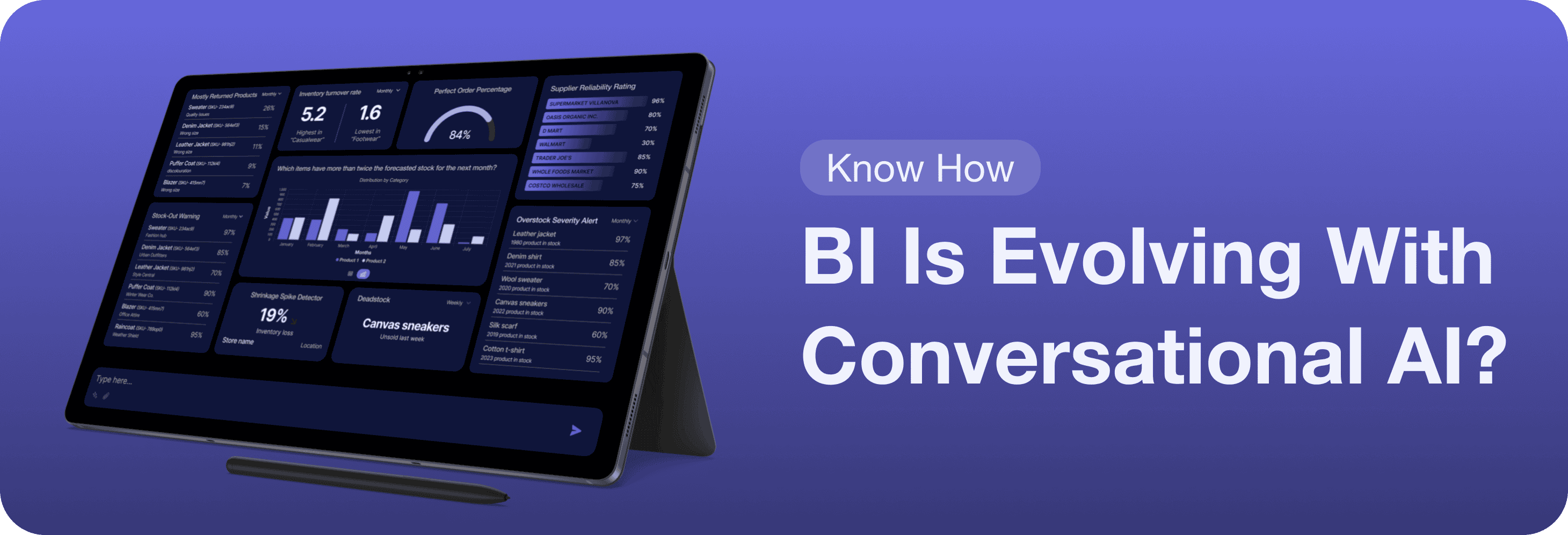For years, dashboards have been the staple of business intelligence (BI) and rightfully so. They provide all key metrics at a glance. However, as with everything, evolution is bound to happen. BI is in the throes of a fascinating revolution: Conversational AI.
Thanks to Natural Language Processing (NLP) and Large Language Models (LLM), simply asking, “Why did sales dip last quarter in the Western region?” can deliver insightful answers in seconds. Let’s explore this incredible change in more detail.
The Dashboard Dilemma
Dashboards have been the primary interface for BI for decades. However, they’re not without their limitations. They can only provide you with an overview without the nuances you need to make decisions. As data volumes exploded from petabytes to zettabytes, the limitations of dashboards became glaringly obvious.
The What vs. Why Gap
Traditional dashboards shine at presentations. They excel at showing the “what” through visual summaries of KPIs. But what about the why? Even the best of metrics without contextual understanding of underlying drivers won’t get you anywhere.
For instance, you might see a sudden spike in production costs. To find out the reasons behind this, you’ll have to manually connect the dots and consult with analysts, which is extremely time-consuming. Is it rising raw material prices? Inefficient machinery? Overtime hours? The dashboard offers the symptom, not the diagnosis.
Rigid Exploration Paths
Dashboards are typically constructed with a specific set of questions and analytical paths in mind. You can drill down, filter, and segment, but only within the tight confines set by the dashboard. What if something unforeseen comes up? Or when you want to check relationships between two metrics? Are you going to modify or redesign the dashboard? This inherent inflexibility limits your curiosity and fails to address ad hoc questions that arise during day-to-day work.
Information Overload
Most dashboards end up becoming cluttered with excessive metrics and visualizations as the amount of data increases. That’s bound to happen as your business grows. You get bombarded with information, and extracting focused, actionable insights becomes your job. When most of your team is relying on the same dashboards, it becomes cumbersome to sift through layers of data, much of which may be irrelevant to their specific role, to find what matters. It’s difficult to pinpoint what truly matters.
Dependency on Technical Expertise
While creating and modifying dashboards may seem like a solution, it’s not as easy as it seems. It requires specialized skills in data visualization or SQL. This dependency on technical teams creates bottlenecks.
Business leaders will have to wait for analysts to do their job in order to access the insight they need. This slow approach will lead to delayed responses to critical business issues and missed opportunities.
Reactive Rather Than Proactive
Fundamentally, traditional dashboards are reactive tools. They show what’s happening and what has happened, offering a rear-view mirror perspective. Yes, it does help you understand past performance. But it doesn’t naturally suggest the next best action or proactively predict future outcomes. You have to figure that out yourself.
Dashboards also don’t highlight hidden opportunities or flag potential risks before they escalate, making BI more of a reporting function than a strategic guidance system.
The Need for Conversational BI
Conversational AI is addressing these limitations by integrating language processing technologies with BI tools. They empower you to interact with complex datasets in plain language. Instead of navigating dashboards or writing code, you can ask questions, request analyses, and receive insights through dynamic dialogues.
All of this is possible due to these three key AI technologies:
- Natural Language Processing (NLP): This is the AI’s ability to understand human language. It helps understand user intent by breaking down text, analyzing grammatical structure, and identifying key terms to translate natural language questions into structured queries that data systems can understand. It’s what turns “How did our new product perform in Texas last month?” into a precise data retrieval command.
- Large Language Models (LLMs): Building upon NLP, LLMs are the engines that process these interpreted queries. They retrieve relevant information from various sources and create contextually appropriate, nuanced answers in natural language. They can handle the complexity of human language and provide comprehensive answers.
- Generative AI: Going beyond simply answering questions, GenAI can create new content. In the BI context, it helps generate concise summaries of complex findings and even create visualizations based on simple prompts. Ask for “a bar chart showing regional sales growth,” and it appears.
These capabilities directly address the pain points of traditional dashboards. They allow BI tools to provide actionable insights in plain language. They provide automated contextualization, explaining the “why” behind numbers. You can ask follow-up questions like “What were the contributing factors to that sales dip?” or “Compare that to the previous quarter,” and go beyond a static view.
Transformative Benefits Across the Enterprise
The shift from static data to conversational insights creates a ripple effect that benefits your entire organization.
Democratization of Data
By allowing users to get insights by asking questions in plain language, conversational AI removes technical barriers associated with traditional tools. Now, every employee across all departments can access actionable insights and make data-driven decisions. More than access to data, conversational AI can break down complex insights in easy-to-understand language, making it easy for non-technical users to utilize in their day-to-day activities.
Accelerated Insights
No one will wait for hours to get insights. With conversational AI, you can ask business questions and get insights then and there. This agility allows you to respond to fleeting opportunities and market changes ASAP. The interactive nature of conversational BI tools allows you to ask follow-up questions on the fly and get better insights.
Personalization at Scale
AI algorithms excel at learning and adapting. By integrating AI in data analytics, you can extract customized insights based on a user’s role, responsibilities, past interactions, common queries, and even their preferred method of information consumption, e.g., charts, summaries, or detailed tables.
This is a big upgrade from traditional dashboards, which offer the same insights to all. Now, users can get insights that are most relevant to them.
From Information to Action
Perhaps the most significant benefit is the ability of conversational BI to bridge the often-tricky gap between information and action. It can now suggest potential actions or highlight correlations that warrant attention, helping you make smarter decisions. Instead of simply reporting the past, BI can help you prepare for the future. It’s a strategic tool that guides future strategy.
Real-World Applications
The practical applications of conversational BI shine across various business functions:
- Marketing Manager: Can ask “What was our cost per lead for the Q3 ‘Summer Splash’ social media campaign compared to Q2?” and receive precise CPL data, comparative analysis, and potential explanations for variances.
- Sales Leader: Might query “Show me the top 3 underperforming products in EMEA this quarter by sales revenue against target. What common themes appear in customer feedback?” and receive product performance data and sentiment analysis from customer feedback.
- Operations Head: Could inquire “Identify the primary bottlenecks in our order fulfillment process over the last month and quantify their average delay impact.” This would return bottleneck analysis and delay quantification.
- Executive Leadership: Might ask “Summarize our financial performance last quarter against targets. What are the top strategic risks and opportunities?” and receive key financial metrics versus targets and AI-identified strategic implications.
The Future: Dashboards Get Smarter
While it may seem that dashboards will become obsolete, the emerging reality is more nuanced. Dashboards are evolving and will continue to provide immense value for at-a-glance monitoring of core KPIs. It’s the kind of information you want to see every morning, such as an overview of your business health.
In the future, we’re going to see a fusion of intelligent dashboards with embedded conversational features. If you spot an anomaly in the dashboard, you can simply ask the AI then and there for clarification.
Beyond Query and Answer
The current wave of conversational BI is just the beginning. The trajectory points toward:
- Proactive and Prescriptive Insights: Future BI systems won’t wait for your questions. They’ll analyze your patterns and anticipate your needs and provide insights before you even ask. They’ll turn from reactive to proactive and prescriptive.
- Multimodal Interactions: Why limit ourselves to text? In the future, you’ll be able to engage with your data through combinations of voice, text, gestures, and visual analysis for more intuitive experiences.
- Agentic BI: You’ll get AI-powered agents capable of performing complex analytical tasks autonomously, learning from interactions and evolving data patterns to become more effective over time.
NavAI: Integrate Conversational BI in Your Business
NavAI is the latest innovation in conversational BI and insight generation. Powered by LLM, it allows you to get answers to your most pressing business questions by simply asking your data in your language. It’s your gateway to a future where critical business insights are, quite literally, just a conversation away.
NavAI Features:
- Analyze the Past
- Predict the Future
- Prescribe the Solution
- 100+ Languages Supported
- 320+ Integrations
Switch to NavAI!
FAQs
Can conversational AI create charts and visualizations like dashboards do?
Absolutely, NavAI is powered by GenAI and can interpret requests like, “Show me a bar chart comparing sales performance across all regions last quarter.” It can automatically generate that visual in seconds. This is a huge step up from pre-built dashboard views.
How “natural” are we talking with this Natural Language Processing (NLP)?
As natural as talking to your colleague. AI has evolved to the level that it can understand complex business jargon, typos, and nuances so that you can talk with it literally in conversational language. You shouldn’t need to remember specific technical terms or data field names. The AI can still interpret your request.
Are there concerns about the AI providing incorrect information based on the data?
The quality of responses you get from LLMs is proportional to the quality of data you feed it. That’s why we at NavAI make it a priority to ensure your data is cleaned before feeding it to the AI to increase its accuracy.
Does giving everyone access through a conversational interface raise security risks?
Data security becomes more critical when you’re making data more accessible. At NavAI, we provide role-based access to ensure users can only access data they are authorized to see. The AI will only pull out information that the user has the right to view.
How quickly can my team get up to speed with using conversational BI?
One of the biggest advantages of conversational BI is that it has a very low barrier to entry. The interface is built on natural language, and users can get started much faster than with complex dashboard filters or learning a query language. The focus shifts from how to access the data to what questions you want to ask.











